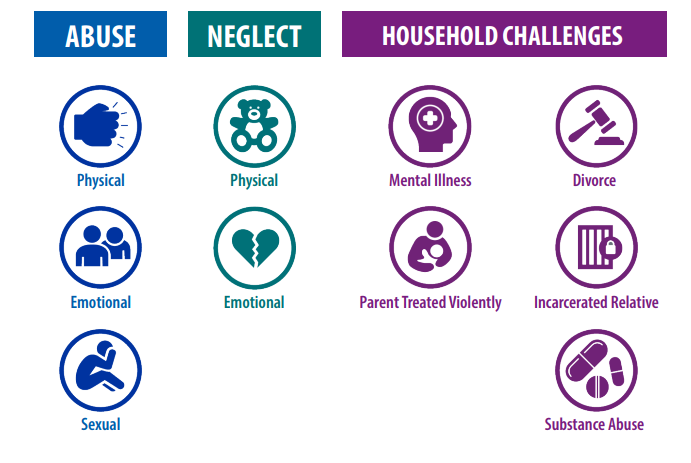4.4 Factors That Lead to Actual and Potential Family Health Problems
Adverse Childhood Experiences
Family dysfunctions can cause adverse childhood experiences. Adverse childhood experiences (ACE) is a term that refers to physical and emotional neglect; physical, emotional, and sexual abuse; divorce; imprisonment of a family member; witnessing substance abuse or mental illness of a family member; or witnessing a parent treated violently.
In the late 1990s, a large research study evaluated the impact of adverse childhood experiences on adult health for over 17,000 participants, referred to as the Adverse Childhood Experiences Study. The findings showed that the more negative events a child experienced, the higher their likelihood of developing adolescent risky behavior, such as substance misuse or unprotected sexual activity resulting in pregnancy. Adults who experienced ACE had a higher likelihood of many chronic illnesses, such as alcoholism, chronic pulmonary disease, depression, and liver disease. Furthermore, adults with the highest ACE levels had a 20-year lower life expectancy.[1],[2] See Figure 4.4[3] for an illustration of adverse childhood experiences.

Risk Factors and Protective Factors
Many risk factors contribute to ACE, including family dynamics and community characteristics. ACE are preventable when protective factors are implemented in families and communities.[4] Nurses assess family risk factors for ACE and implement prevention strategies.
Risk factors in families that increase the likelihood of ACE include the following conditions[5]:
- Caregiving challenges related to children with special needs (for example, chronic illness, disabilities, or mental health disorders)
- Caregivers who have a limited understanding of children’s needs or development
- Caregivers who were abused or neglected as children
- Young caregivers
- Single parents
- Families with low income or low levels of education
- Families experiencing high levels of financial stress
- Families that use inconsistent discipline or spanking
- Families with low levels of parental supervision
- Families who are isolated and do not have a support system of extended family, friends, or neighbors
- Families experiencing high interpersonal conflict and/or negative communication styles
- Families with attitudes that accept violence or aggression
Community risk factors for ACE include these attributes[6]:
- High rates of violence and crime
- Limited educational and economic opportunities
- High rates of poverty, unemployment rates, and food insecurity
- Easy access to drugs and alcohol
- Low community involvement among residents
- Few community activities for youth
- Unstable housing where residents move frequently
Protective factors are conditions that decrease the risk of ACE. Individual and family protective factors against ACE include the following[7]:
- Families that meet family members’ basic needs of food, shelter, and health services
- Families that create a stable, secure life where children feel safe and supported in nurturing relationships
- Families that have strong social support networks and positive relationships
- Families that engage in fun, positive activities together
- Families that encourage the importance of school for children
- Families whose members work through conflicts peacefully
- Children have caring adults outside the family who serve as mentors/role models
- Parents/caregivers have a college degree or higher education
- Parents/caregivers have steady employment
- Parents/caregivers provide effective supervision and discipline
- Parents/caregivers effectively help children work through their problems
Nurses can implement preventive interventions in their communities to reduce the risks for ACE. Community protective factors include the following[8]:
- Education and support regarding positive parenting
- Financial assistance
- Medical care and mental health services
- Safe, stable housing
- Safe, nurturing childcare
- High-quality preschool programs
- Safe, engaging after-school programs and activities
- Career opportunities with family-friendly policies for adults
View Figure 4.5[9] for an image of positive parenting in a community setting.

Divorce
Divorce is an adverse childhood experience. The degree to which divorce affects a child’s development is influenced by how the parents treat each other before, during, and after the divorce. Parents must work together to make the transition as easy as possible for their children. Even though their marriage ends, their role as an involved parent continues. Nurses can encourage the following recommendations for divorced parents[10]:
- Never force the child to take sides. Every child will have loyalties to both parents.
- Do not involve the child in arguments between the two parents.
- Do not criticize each other in front of your child or when your child might overhear you. If this happens, explain to your child that when people get angry, they sometimes say things that are hurtful.
- Avoid fighting in front of your child.
- Talk with your child about the divorce early and often.
- Allow your child to share their fears, worries, and feelings with you. This can help make them feel safe and special.
When talking with a child about divorce, encourage parents to follow these guidelines[11]:
- Be completely honest and open about what is going to happen. Talk about the divorce in simple terms. For example, “Your dad and I are having some trouble getting along,” or “Your mother and I are thinking we may need to separate.”
- Make sure the child knows the divorce is not their fault and they can’t fix the problems to make the parents stay together.
- Reassure the child that you love them and will not leave them.
- Do not blame your ex-spouse or show anger toward them in front of the children. Explain that parents sometimes need to live separately.
- Be patient with the child’s questions; do not feel you must have all the answers. Sometimes just carefully listening to your child is more helpful than talking.
It is important to allow children to show their love to both parents. Unless the ex-spouse is considered unfit to parent, children should be allowed to spend time with them without feeling guilty. Reassure children that both parents still love them even though they may be living with only one parent at a time.[12]
Try to keep the child’s routine, friends, school, and environment as unchanged as possible. Schedule meals, chores, and bedtime at regular times so the child knows what to expect each day. Parents living separately should agree on a set of consistent rules for both households and live up to promises to visit or spend time with the child. A routine weekly or monthly schedule may provide comfort, security, and stability to the child.[13]
Children may turn to neighbors, grandparents, and friends for comfort and attention. These outside relationships can offer support and may be very helpful to children as they adjust to divorce. Teachers or school guidance counselors should be made aware of divorce proceedings so they can inform the parents if problems arise in school.[14]
- Ernstmeyer, K., & Christman, E. (Eds.). (2022). Nursing: Mental health and community concepts. https://wtcs.pressbooks.pub/nursingmhcc/ ↵
- Leitch, L. (2017). Action steps using ACEs and trauma-informed care: A resilience model. Health & Justice, 5(2017), 1-10. https://doi.org/10.1186/s40352-017-0050-5 ↵
- “ACEs” by unknown author for Centers for Disease Control and Prevention is licensed in the Public Domain. Access the source PDF for free at https://www.cdc.gov/injury/pdfs/priority/ACEs-Strategic-Plan_Final_508.pdf ↵
- Centers for Disease Control and Prevention. (2023). Risk and protective factors. https://www.cdc.gov/ ↵
- Centers for Disease Control and Prevention. (2023). Risk and protective factors. https://www.cdc.gov/ ↵
- Centers for Disease Control and Prevention. (2023). Risk and protective factors. https://www.cdc.gov/ ↵
- Centers for Disease Control and Prevention. (2023). Risk and protective factors. https://www.cdc.gov/ ↵
- Centers for Disease Control and Prevention. (2023). Risk and protective factors. https://www.cdc.gov/ ↵
- “girl-2480361_1920.jpg” by unknown author from Pixabay is licensed under CC0 ↵
- American Academy of Pediatrics. (2015). Adjusting to divorce. https://www.healthychildren.org/English/family-life/family-dynamics/types-of-families/Pages/Adjusting-to-Divorce.aspx ↵
- American Academy of Pediatrics. (2015). Adjusting to divorce. https://www.healthychildren.org/English/family-life/family-dynamics/types-of-families/Pages/Adjusting-to-Divorce.aspx ↵
- American Academy of Pediatrics. (2015). Adjusting to divorce. https://www.healthychildren.org/English/family-life/family-dynamics/types-of-families/Pages/Adjusting-to-Divorce.aspx ↵
- American Academy of Pediatrics. (2015). Adjusting to divorce. https://www.healthychildren.org/English/family-life/family-dynamics/types-of-families/Pages/Adjusting-to-Divorce.aspx ↵
- American Academy of Pediatrics. (2015). Adjusting to divorce. https://www.healthychildren.org/English/family-life/family-dynamics/types-of-families/Pages/Adjusting-to-Divorce.aspx ↵
A term that refers to physical and emotional neglect; physical, emotional, and sexual abuse; divorce; imprisonment of a family member; witnessing substance abuse or mental illness of a family member; or witnessing a parent treated violently.

